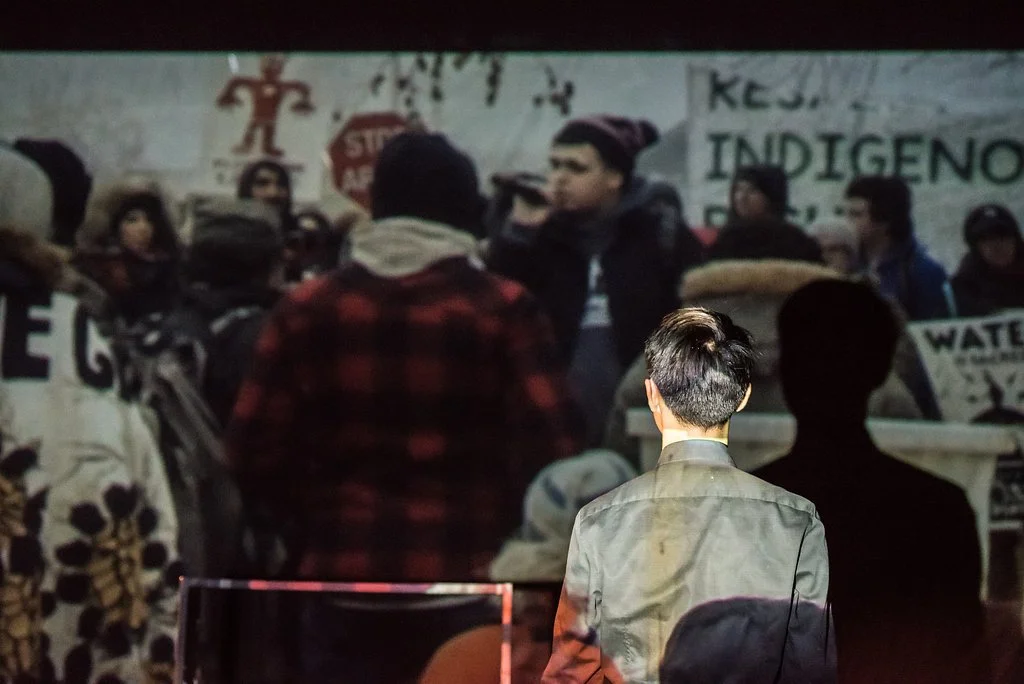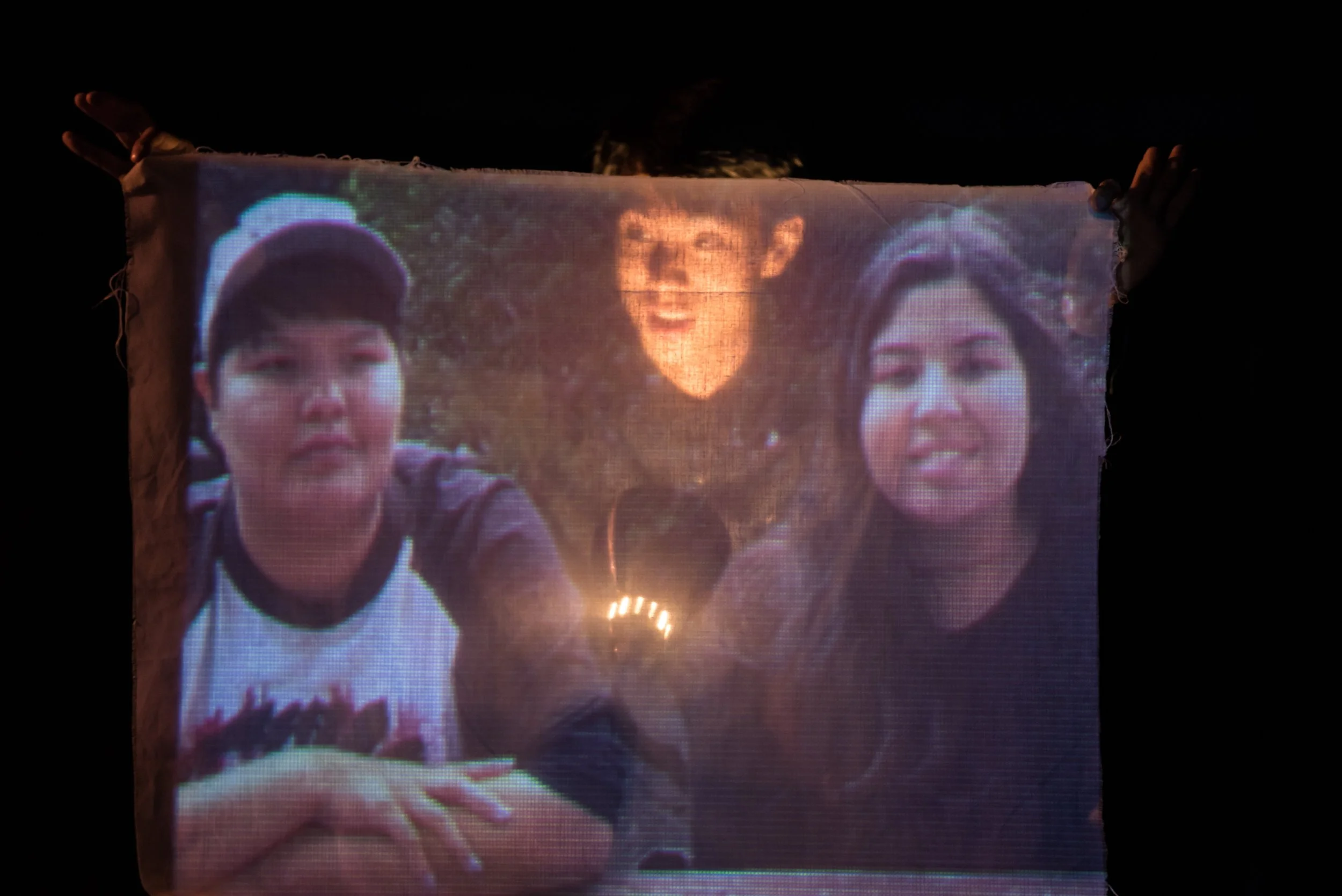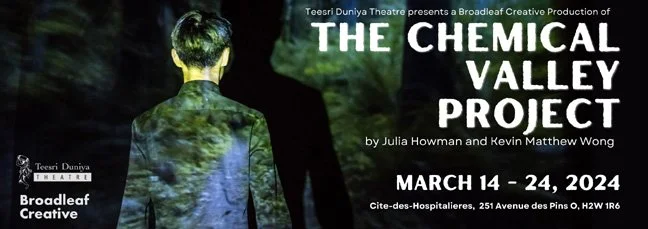Creating Meaningful Theatre - The Chemical Valley Project
Photo by Dahlia Katz
As Rahul Varma, Artistic Director of Teesri Duniya Theatre, stood centre stage and welcomed us to their new performance space, Rangshala Studio, located in Cité-des-Hospitalières on des Pins Ouest, I felt a brief moment of hope wash over me. Performance spaces, particularly new performance spaces, are few and far between in Montreal, a dire situation growing worse each day. After the warm welcome, Varma went on to speak about the numerous genocides currently being perpetrated around the world. “One day, the survivors will come to us and ask us what we were doing when it was happening,” he explained, “and we’re going to have to answer them. And if we say, we were creating theatre, we will have to defend that. Did we make meaningful theatre?” The message was clear, and on-brand for Rahul Varma and the Teesri Duniya Theatre Company, who’s website reads “Change the world, one play at a time” in large, bold letters on their homepage. It is this motivation, this objective, behind Teesri Duniya’s presentation of Broadleaf Creative’s The Chemical Valley Project.
Years ago, after first experiencing Tectonic Theatre Project’s Gross Indecency: The Three Trials of Oscar Wilde, I became fascinated with documentary theatre. This is a broad term that includes many subgenres such as “research theatre”, “verbatim theatre”, and “lecture theatre”. Some productions will use creative narrative elements, and direct quotations, particularly if telling a personal story (Tectonic’s The Laramie Project, as an example). Others will lean into the “lecture” aspect, and information is presented more formally. An excellent example of this is The Noam Chomsky Lectures, by Canadian playwrights Daniel Brooks and Guillermo Verdecchia. Following in these footsteps, The Chemical Valley Project, co-created and performed by Kevin Matthew Wong, moves fluidly through each subgenre, weaving together a production that is both informative and intimate. While this is the Montreal premiere of the play, the piece has been performed in numerous iterations over the last eight years. That refinement and attention to detail only afforded by time itself is on display at the outset. Beginning our journey with an allegory about a hummingbird’s reaction to a forest fire, the piece builds a momentum it maintains for 75 captivating minutes.
Photo by Dahlia Katz
The Chemical Valley Project is a production about the Aamjiwnaang First Nation on the banks of the St. Clair River, near Sarnia, Ontario, and the physical and emotional damage done to its people by the over 60 petrochemical plants and oil refineries operating in the surrounding area. There are only 900 living on the reserve, and Wong begins the production by delivering a clever, if not depressing, factual lecture highlighting the daily horrors experienced by the Aamjiwnaang people. Irregular birth rates, increased occurrences of still-births and miscarriages, severe asthma and stress are regular ways of life for the people surrounded by these plants, with little to no power to change their situation. The effects of environmental racism are painfully evident, we know about this, and yet it isn’t something on the forefront of most people’s minds, rarely discussed in mainstream media. But, the message is clear: knowing about it isn’t enough. We need to take the time to understand. As Wong says to us, “understanding is knowledge with a beating heart.”
It’s with this goal of understanding that Kevin Matthew Wong then introduces us to the two people that were the catalyst for the piece we’re currently experiencing: Vanessa Gray and Beze Gray, sibling activists from the Aamjiwnaang First Nation. It’s here where the story is taken from “lecture theatre” into something more intimate, more personal. From the siblings, we hear first-hand accounts of life on the reserve. We see photos, videos, and hear anecdotes about growing up in Chemical Valley. The multimedia is a patchwork of television clips, and Wong’s own recordings, covering the span of the show’s inception and creation. Serving as advisors and dramaturgs for the production, we learn about the siblings’ work as land defenders and water protectors, their temporary shut down of Enbridge Energy’s infamous “Line 9”, and their subsequent court case for this activism. A necessary epilogue outlines the sibling’s current projects, and how we can involve ourselves.
Beze Gray, Kevin Matthew Wong, and Vanessa Gray - Photo by Dahlia Katz
Kevin Matthew Wong and co-creator Julia Howman create a charming, and innovatively engaging narrative, weaving together both lecture and personal interest into a strong, well-rehearsed, and well-choreographed, piece of documentary theatre. Wong moved effortlessly around the stage, commanding the detailed attention of the audience. The sound design, by Frank Incer, allows us to immerse ourselves in the audio recordings, the world of the story, without feeling like we were witnessing a presentation (something that sets this piece apart from its film-based counterparts). In this version of the production, Julia Howman’s lighting design instigates our imaginations on a stage with a minimal set. Using bold lighting choices, puppetry, and expert shadow work, she creates fuller, more elaborate settings than just the simple white table at centre stage. I have particular appreciation for the innovative use of projections, and projection mapping on a variety of surfaces and material, throughout the piece, giving the audience one unique visual after another, pushing us far, far away from the most traditional of documentary theatre. The new Teesri Duniya theatre is large and versatile, and yet this incredibly intimate production managed to fill the entire space, surrounding us, keeping us close to the heartbeat of the play.
Within the piece, Kevin Matthew Wong illustrates to the audience how he came to this story, to create this production, after discovering the work of Vanessa Gray and Beze Gray. His clear, articulated delivery, his confidence and self-referential humor, provides the audience with a clear path to find their own way into the story. Before ending, Wong brings the production full-circle, back to the allegory of the hummingbird and the forest fire, dropping a single drop of water on the flames, over and over and over again. I’m doing the most I can, the hummingbird cries to his fellow animals watching their home burn. I’m doing the most I can. As much as that story is meant to apply to each of us individually, and the understanding that we can only do so much, but we must DO THAT MUCH, it’s also a decent metaphor for meaningful theatre, and a justification for more documentary theatre such as this piece. As Rahul Varma said at the top of the evening, it’s important to make meaningful theatre. The Chemical Valley Project is meaningful theatre. Each entertaining and skillful performance of this play is yet another drop of water on that raging fire, and that is wildly inspirational.
Kevin Matthew Wong’s next production, Benevolence, documenting the Hakka-Chinese experience in Canada, is currently in development. This expansive piece includes a theatrical presentation, a short film, and a museum installation.
The Chemical Valley Project is on NOW until March 24th - Buy your tickets HERE!
To learn more about the Aamjiwnaang First Nation visit AAMJIWNAANG SOLIDARITY AGAINST CHEMICAL VALLEY
For more information about Broadleaf Theatre, visit their website.
The Teesri Duniya Theatre Company can be found here.
Visit Kevin Matthew Wong’s website for more about his creative journey.




